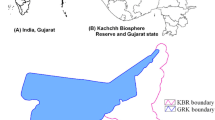Abstract
Starting with the intensification of irrigation activities in the beginning of 1980s in Abaya and Chamo lakes area, the decreasing water inflow to the lakes caused denudation of the wetlands. The ecological situation in the lake region changed significantly during last four decades. The lakes and associated wetlands change have been studied using Landsat MSS (1973), Landsat TM (1986), and Ladsat ETM (2000) satellite imagery. Along with satellite imagery, other hydro-meteorological data were collected and hydro-meteorological data analyses were done to assess the variability of wetlands. From these data, lakes morphometric property estimation at different time series and water balance analysis for both lakes were done. Wetlands are mapped from the TCT image and these maps are subject to change detection to see the temporal and spatial variability of the wetlands. Moreover, the lake-morphometric area and volume variation have been studied. The result showed that between 1986 and 2000, a significant reduction has been observed but lesser than the previous decades (6.4 km2). The identified reason behind this change is that the free settlement and shoreline cultivation of the wetlands causing the soil erosion and eventually adds the sediment to the wetlands.
Similar content being viewed by others
References
Armenakis, C., Leduc, F., Cyr, I., Savopol, F., & Cavayas, F. (2003). A comparative analysis of scanned maps and imagery for mapping applications. ISPRS Journal of Photogrammetry and Remote Sensing, 57, 304–314.
Collins, J. B., & Woodcock, C. E. (1994). Change detection using the Gramm–Schmidt transformation applied to mapping forest mortality. Remote Sensing of Environment, 50, 267–279.
Collins, J. B., & Woodcock, C. E. (1996). An assessment of several linear change detection techniques for mapping forest mortality using multitemporal landsat TM data. Remote Sensing of Environment, 56, 66–77.
Dugan, P. (1993). Wetlands in danger: A world conservation atlas (pp. 190). New York: Oxford University Press.
Dymond, C. C., Mladenoff, D. J., & Radeloff, V. C. (2002). Phenological differences in Tasseled Cap indices improve deciduous forest classification. Remote Sensing of Environment, 80, 460–472.
EPA (2006). Management plan for the conservation and sustainable utilization of Abaya and Chamo wetlands Evans, J. (ed.). (2004). Unsupervised Classification Algorithms. Yale University.
Finlayson, C. M., & van der Valk, A. G. (1995). Wetland classification and inventory: A summary. Vegetation, 118, 185–192.
Jensen, J. R. (1996). Introductory digital image processing (3rd ed.). Upper Saddle River, NJ: Prentice Hall.
Kassawmar (2007). Land use land cover dynamics analysis in the catchment of Abaya and Chamo, Southern Ethiopia. Unpublished MSc thesis, Addis Ababa University, Ethiopia.
Lillesand, T. M., & Kiefer, R. W. (1994). Remote sensing and image interpretation (3rd ed.). New York: Wiley.
Lyon, J. G. (1993). Practical handbook for wetland identification and delineation (pp. 157). Ann Arbor: Lewis. Analytical Spectral Device Inc, 2002. ASD User’s Guide, USA, pp. 148.
Mitsch, W. J., & Gosselink, J. G. (2000). The value of wetlands: Importance of scale and landscape setting. Ecological Economics, 35, 25–33.
Parmenter, A. W., Hansen, A., Kennedy, R., Cohen, W., Langner, U., Lawrence, R., et al. (2003). Land use and land cover change in the greater Yellowstone ecosystem: 1975–1995. Ecological Applications, 13, 687–703.
Seleshi, B. A. (2000). Investigation of water resources aimed at multi-objective development with respective limited data situation: The case of Abaya–Chamo basin, Ethiopia.
Thomas, V., Treitz, P., Jelinski, D., Miller, J., Lafleur, P., & McCaughey, H. (2002). Image classification of a northern peatland complex using spectral and plant community data. Remote Sensing of Environment, 84, 83–99.
Thompson, J. A., Bell, J. C., & Butler, C. A. (1997). Quantitative soil-landscape modeling for estimating the areal extent of hydromorphic soils. Soil Science Society of America Journal, 61, 971–980. Academy of Natural Sciences of Philadelphia, 144, 240–253.
Whigham, D. F. (1999). Ecological issues related to wetland preservation, restoration, creation and assessment. The Science of the Total Environment, 240, U.S.
Author information
Authors and Affiliations
Corresponding author
Additional information
This research work has succeeded in estimating spatio-temporal changes of wetlands for the reason these changes should be estimated and associated factors affecting the changes should be determined for the sustainable management of wetlands.
Rights and permissions
About this article
Cite this article
Tibebu Kassawmar, N., Ram Mohan Rao, K. & Lemlem Abraha, G. An integrated approach for spatio-temporal variability analysis of wetlands: a case study of Abaya and Chamo lakes, Ethiopia. Environ Monit Assess 180, 313–324 (2011). https://doi.org/10.1007/s10661-010-1790-z
Received:
Accepted:
Published:
Issue Date:
DOI: https://doi.org/10.1007/s10661-010-1790-z




